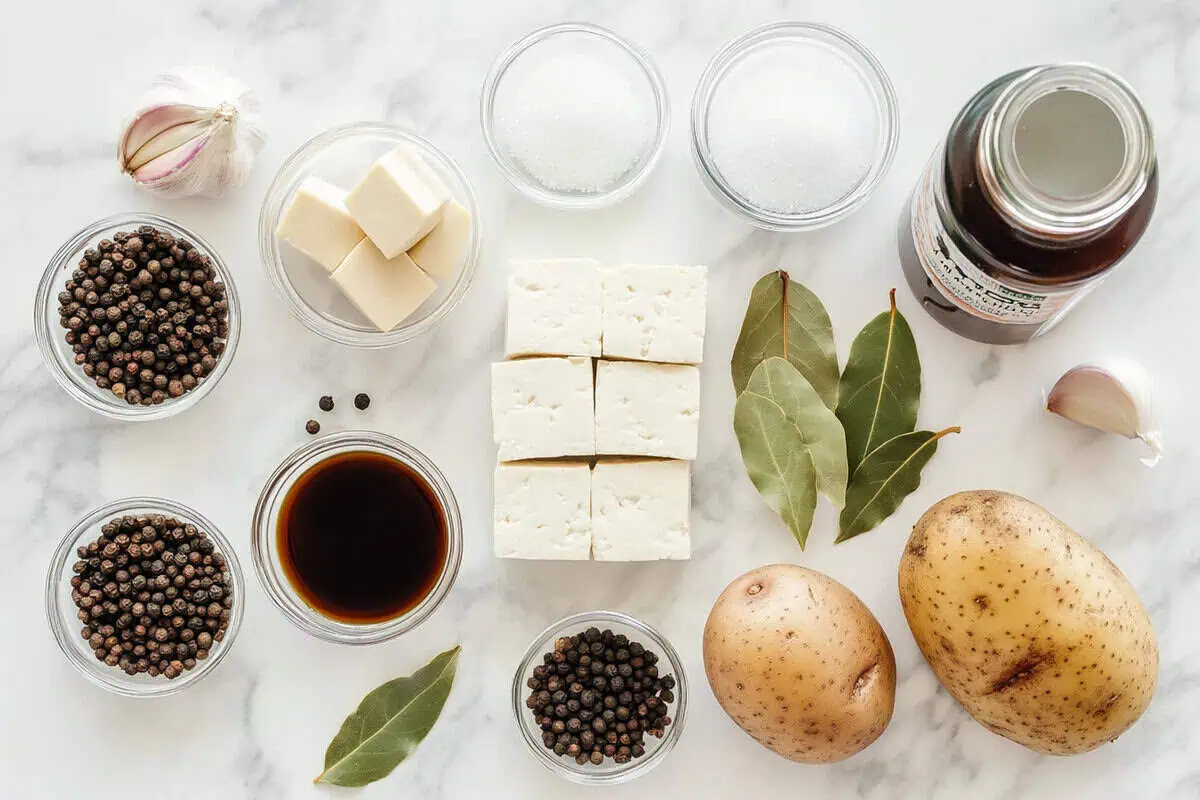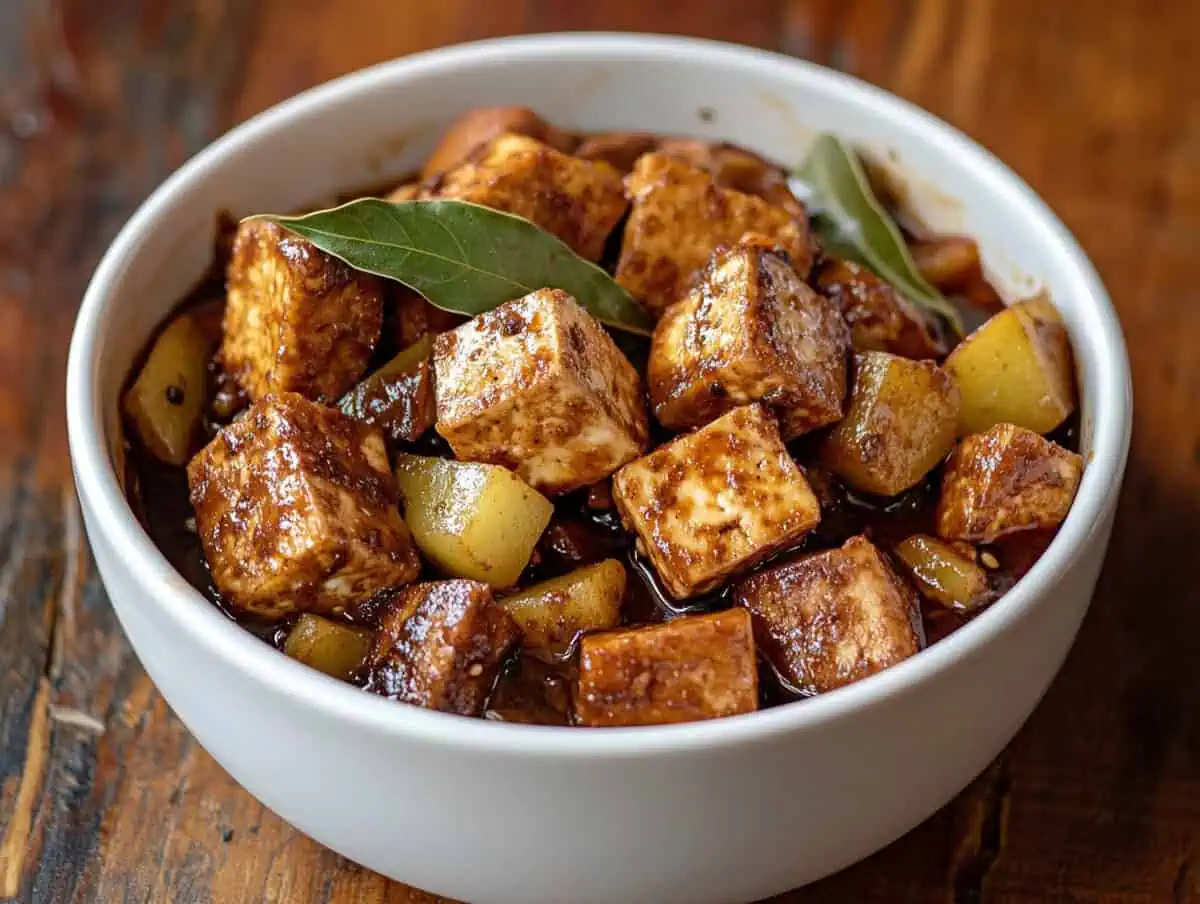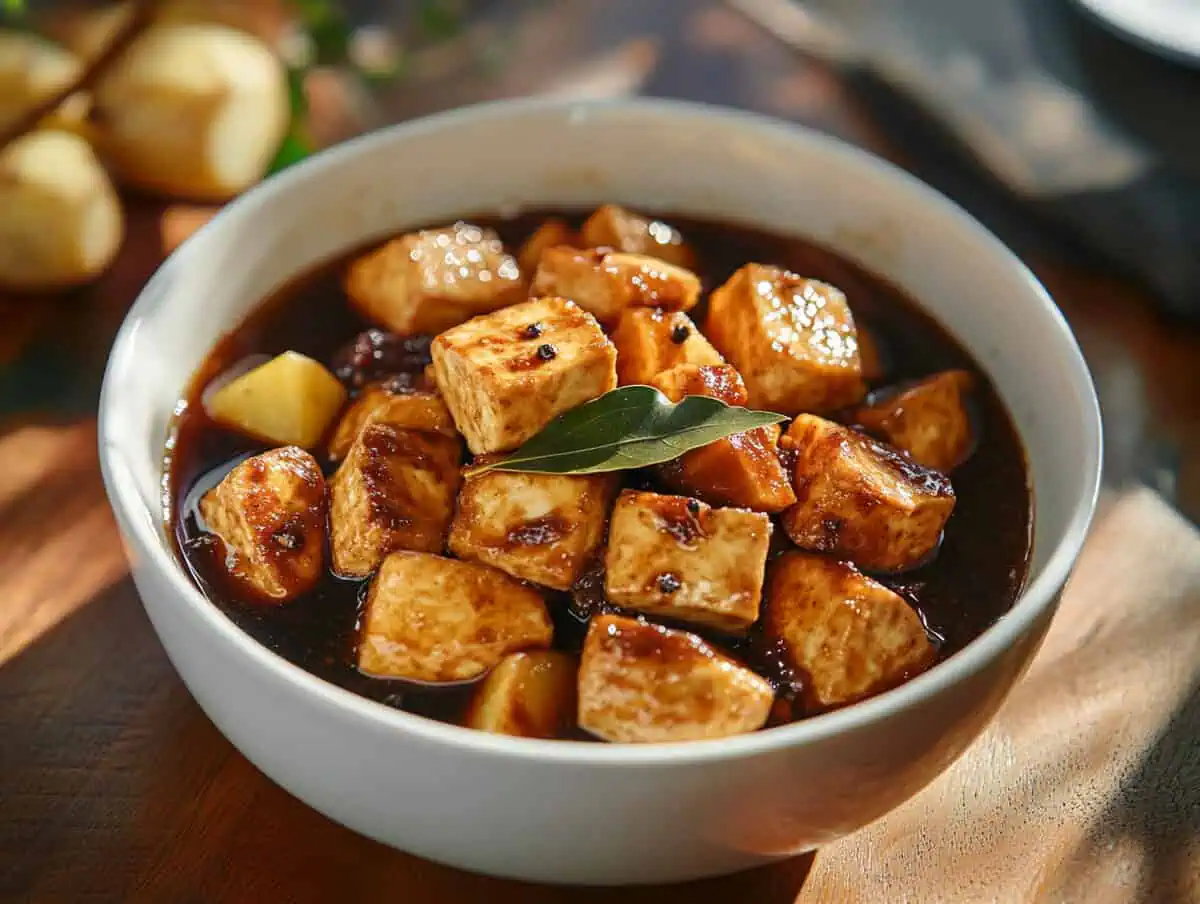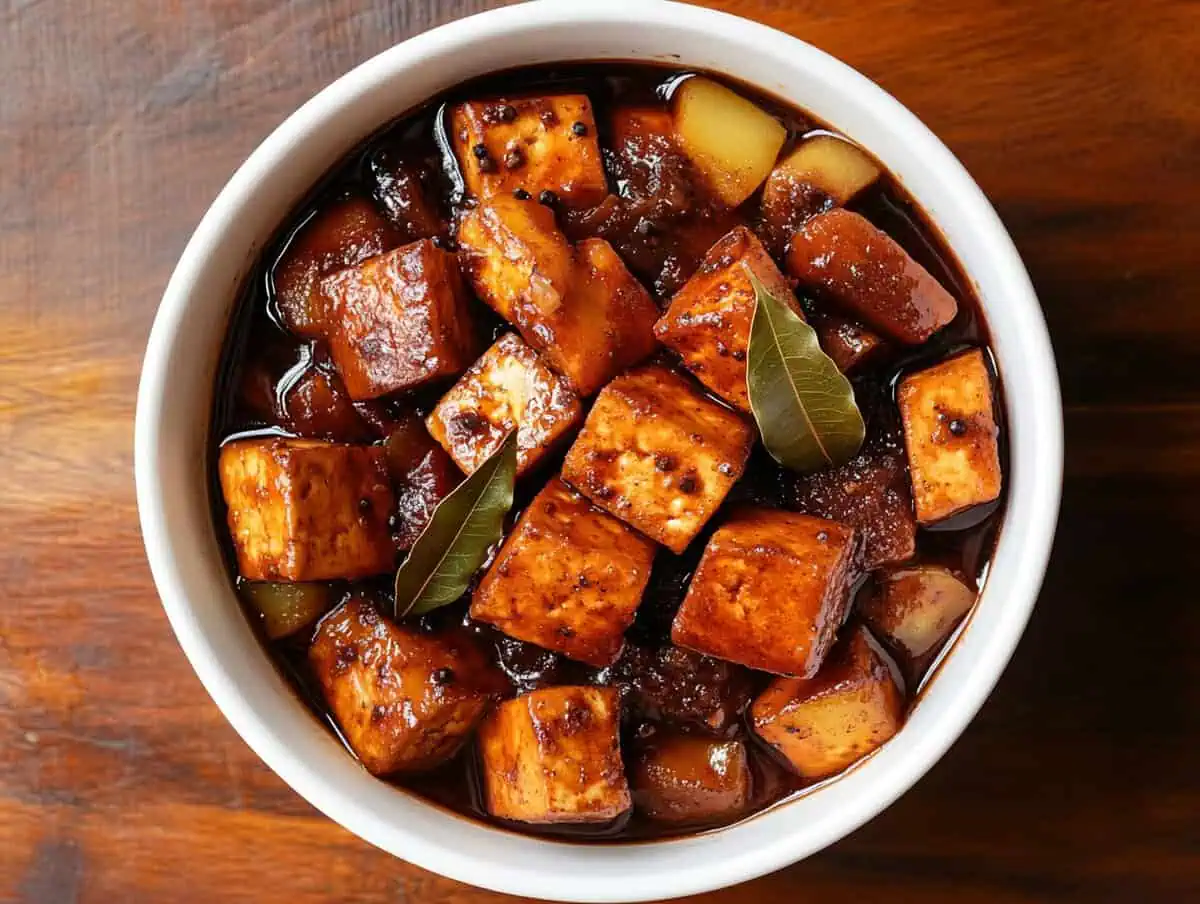Welcome to my favorite plant-based twist on a Filipino classic! This Tofu Adobo (Adobong Tokwa) brings all the tangy, savory goodness of traditional adobo to your table without any meat.
After years of missing my mom's famous chicken adobo after going vegetarian, I finally perfected this tofu version that satisfies all my comfort food cravings. The tofu soaks up the rich sauce made with vinegar, soy sauce, and aromatic spices, creating a dish that's incredibly simple to make but packed with bold flavors.
The best part? It tastes even better the next day, making it perfect for meal prep. Serve it over a bed of steaming white rice to soak up all that delicious sauce.
What is Filipino Adobo?
Filipino Adobo is the unofficial national dish of the Philippines, consisting of meat, seafood, or vegetables marinated and braised in a mixture of vinegar, soy sauce, garlic, black peppercorns, and bay leaves.
While the most common versions use chicken or pork, this vegan adaptation with tofu captures the same complex flavors and satisfying experience of the original dish. Every Filipino family has their own special version, and this recipe comes straight from my mother's kitchen, where it was perfected over generations.
Jump to:
Why You'll Love This Recipe
This vegan Filipino Tofu Adobo delivers all the bold, savory flavors of traditional adobo without any meat. The firm tofu soaks up the rich sauce of vinegar, soy sauce, and aromatic spices, creating a dish that's incredibly satisfying and packed with umami. Each bite offers the perfect balance of tangy, savory goodness that pairs beautifully with steamed rice. This recipe is:
- Easy to prepare with simple, accessible ingredients
- Budget-friendly and perfect for meal prep
- Authentically flavored based on a traditional family recipe
- Hearty and filling while being completely plant-based
- Quick enough for weeknights but impressive enough for guests
Ingredients
I've carefully selected these ingredients to recreate the authentic flavors of Filipino adobo while keeping it plant-based. The extra-firm tofu provides the perfect texture to absorb the rich sauce, while the combination of soy sauce, vinegar, and aromatics creates that classic tangy-savory profile that defines adobo.
The Better Than Bouillon adds depth that would traditionally come from meat, and the potatoes make the dish heartier and help soak up all those delicious flavors. Don't skimp on the garlic, peppercorns, or bay leaves - they're essential for that authentic taste.

- 1 block extra-firm tofu, pressed, drained, and cut into cubes
- ⅔ cup soy sauce
- ½ cup white vinegar
- ⅓ cup hot water
- 2 teaspoons Better Than Bouillon No Chicken Base
- 1 medium russet potato, peeled and diced
- 6 tablespoons vegetable oil, divided
- 4-6 garlic cloves, minced
- 1 teaspoon whole peppercorns
- 4 bay leaves
- 1½ teaspoons granulated sugar
- Cooked white rice, for serving
Equipment
- Tofu press (or heavy objects and paper towels)
- Large mixing bowl
- Bowl cover or plastic wrap
- Mesh sieve
- Wok or large sauté pan with high sides
- Splash guard (recommended, as the tofu will splatter when frying)
- Measuring cups and spoons
- Sharp knife and cutting board
- Wooden spoon or heat-resistant spatula

How To Make
- Press and drain your tofu for about 30 minutes. Once most of the water has been pressed out, cut the tofu into bite-size squares. Set aside until ready to use.
- Create the marinade by combining the soy sauce, white vinegar, hot water, and Better Than Bouillon No Chicken Base in a large bowl. Mix to combine, ensuring the broth paste has fully dissolved.
- Add the cubed tofu to the marinade, making sure each piece is covered in the sauce. Cover the bowl and allow the tofu to marinate for 30 minutes.
- Drain the tofu over a strainer and reserve the sauce. The sauce is the main component—don't throw it out!
- Heat the oil in a wok or large sauté pan with high sides over medium-low heat.
- Fry the tofu when the oil is hot and glistening. Cook on one side for about 3-4 minutes until browned, then continue until most sides are nicely browned. Be careful, as the tofu will splatter when it hits the oil, so have your splash guard ready.
- Add aromatics - garlic, peppercorns, and bay leaves to the pot. Cook to open up the aromatics, about 2-3 minutes.
- Add the potatoes, reserved sauce, and sugar. Mix to combine. Bring it up to a boil, cover the pan and turn down the heat to medium-low.
- Simmer for 10-12 minutes, stirring occasionally, or until the potatoes are soft.
- Serve over a bed of freshly cooked white rice and enjoy!

Tips from Lola's Kitchen
- Double-press your tofu for best results. After the initial press, cut the tofu, then press again between paper towels for an extra 10 minutes to remove any remaining moisture.
- Don't skimp on the oil - it replaces the richness that would naturally come from animal fat in traditional adobo.
- Toast your peppercorns in a dry pan for 1-2 minutes before adding them to the dish for an even deeper flavor.
- Let the dish rest for 5-10 minutes after cooking to allow the flavors to meld together even more.
- Make it a day ahead if possible - like many stewed dishes, adobo tastes even better the next day when the flavors have had time to develop.
- Cook in a cast iron pan if you have one, as it helps develop a beautiful caramelization on the tofu.
Substitutions
- Soy sauce alternatives: Use tamari for a gluten-free option or coconut aminos for a soy-free version (though this will make the dish slightly sweeter).
- Vinegar variations: White vinegar provides the classic taste, but rice vinegar or apple cider vinegar can work in a pinch.
- No Better Than Bouillon? Use ¼ cup vegetable broth instead of the bouillon and water.
- Sweet potato can replace the russet potato for added nutrition and a subtle sweetness.
- Firm tofu can be used if extra-firm isn't available, but press it longer to remove more moisture.
- Olive oil can replace vegetable oil, though it will add a slightly different flavor profile.
- Brown sugar or coconut sugar can substitute for granulated sugar for a deeper caramel note.
Troubleshooting
- Tofu falling apart? Your tofu might be too soft or not pressed enough. Try freezing and thawing your tofu before pressing for a chewier, more resilient texture.
- Sauce too salty? Add a dash more water and a sprinkle of sugar to balance the flavors.
- Sauce too tangy? Add a bit more sugar or a splash of coconut milk to mellow the acidity.
- Potatoes not cooking through? Cut them into smaller pieces or parboil them before adding to the dish.
- Tofu not browning? Ensure your oil is hot enough and don't overcrowd the pan. Cook in batches if necessary.
- Sauce too thin? Simmer uncovered for a few extra minutes to reduce and concentrate the flavors.
Storage & Reheating
- Refrigeration: Store leftovers in an airtight container in the refrigerator for up to 4 days. The flavors will continue to develop, making it even more delicious the next day.
- Freezing: While you can freeze this dish, the texture of the tofu may change slightly upon thawing. Freeze for up to 2 months in a freezer-safe container.
- Reheating: Gently reheat on the stovetop over medium-low heat, adding a splash of water if needed to loosen the sauce. Avoid microwaving if possible, as it can make the tofu tough.
- Meal prep: This dish is perfect for meal prep! Make a double batch and portion with rice for easy lunches throughout the week.

FAQ
Can I use other proteins instead of tofu?
Absolutely! Traditional adobo uses chicken or pork. For vegan alternatives, try seitan, tempeh, or even meaty mushrooms like king oyster or portobello.
Why do you add potatoes to your adobo?
Potatoes absorb the flavors of the sauce and add heartiness to the dish. This is my family's variation, though not all Filipino adobo recipes include potatoes.
Is this dish gluten-free?
Not as written, due to the soy sauce. Substitute tamari for a gluten-free option.
What makes Filipino adobo different from Spanish or Mexican adobo?
Despite sharing a name (from Spanish colonial influence), Filipino adobo is distinct with its vinegar-soy base, while Spanish and Mexican adobos typically use chilies, herbs, and spices for a completely different flavor profile.
How spicy is this dish?
Traditional Filipino adobo isn't spicy hot. The black peppercorns provide a gentle warmth rather than heat. If you'd like it spicier, add some sliced bird's eye chilies.
Can I add vegetables to this recipe?
Yes! Bell peppers, green beans, bok choy, or spinach make excellent additions. Add leafy greens in the last few minutes of cooking.
What's the best rice to serve with adobo?
Jasmine rice or any long-grain white rice is traditional, but brown rice or cauliflower rice can be used for a healthier option.
Related
Looking for other recipes like this? Try these:

Filipino Tofu Adobo (Adobong Tokwa)
Ingredients
- 1 block extra-firm tofu pressed, drained, and cut into cubes
- ⅔ cup soy sauce
- ½ cup white vinegar
- ⅓ cup hot water
- 2 teaspoons Better Than Bouillon No Chicken Base
- 1 medium russet potato peeled and diced
- 6 tablespoons vegetable oil divided
- 4-6 garlic cloves minced
- 1 teaspoon whole peppercorns
- 4 bay leaves
- 1½ teaspoons granulated sugar
- Cooked white rice for serving
Instructions
- Press and drain your tofu for about 30 minutes. Once most of the water has been pressed out, cut the tofu into bite-size squares. Set aside until ready to use.
- Create the marinade by combining the soy sauce, white vinegar, hot water, and Better Than Bouillon No Chicken Base in a large bowl. Mix to combine, ensuring the broth paste has fully dissolved.
- Add the cubed tofu to the marinade, making sure each piece is covered in the sauce. Cover the bowl and allow the tofu to marinate for 30 minutes.
- Drain the tofu over a strainer and reserve the sauce. The sauce is the main component—don't throw it out!
- Heat the oil in a wok or large sauté pan with high sides over medium-low heat.
- Fry the tofu when the oil is hot and glistening. Cook on one side for about 3-4 minutes until browned, then continue until most sides are nicely browned. Be careful, as the tofu will splatter when it hits the oil, so have your splash guard ready.
- Add aromatics - garlic, peppercorns, and bay leaves to the pot. Cook to open up the aromatics, about 2-3 minutes.
- Add the potatoes, reserved sauce, and sugar. Mix to combine. Bring it up to a boil, cover the pan and turn down the heat to medium-low.
- Simmer for 10-12 minutes, stirring occasionally, or until the potatoes are soft.
- Serve over a bed of freshly cooked white rice and enjoy!
Tips from Lola's Kitchen
- Double-press your tofu for best results. After the initial press, cut the tofu, then press again between paper towels for an extra 10 minutes to remove any remaining moisture.
- Don't skimp on the oil - it replaces the richness that would naturally come from animal fat in traditional adobo.
- Toast your peppercorns in a dry pan for 1-2 minutes before adding them to the dish for an even deeper flavor.
- Let the dish rest for 5-10 minutes after cooking to allow the flavors to meld together even more.
- Make it a day ahead if possible - like many stewed dishes, adobo tastes even better the next day when the flavors have had time to develop.
- Cook in a cast iron pan if you have one, as it helps develop a beautiful caramelization on the tofu.
The Story Behind Filipino Adobo
Filipino adobo holds a special place in Philippine cuisine as the unofficial national dish that has nourished generations across the 7,641 islands of the archipelago. Long before Spanish colonizers arrived in the 16th century and named it "adobo" (from the Spanish word "adobar," meaning to marinate), indigenous Filipinos were already preserving their food in vinegar and salt. This preservation method was perfectly suited to the tropical climate, where food would spoil quickly without refrigeration.
What makes Filipino adobo truly remarkable is its brilliant simplicity. The basic combination of vinegar, soy sauce (which replaced salt after Chinese traders introduced it), garlic, peppercorns, and bay leaves creates a dish that's simultaneously tangy, savory, and slightly sweet. Every region and family throughout the Philippines has their own variation – some add coconut milk for creaminess, others incorporate chilies for heat, or turmeric for color and earthiness.
Growing up in a Filipino household, adobo was our go-to comfort food. My mother would make a big batch every Sunday, and the distinctive aroma would fill our home, signaling that something delicious was simmering on the stove. The beauty of adobo is that it tastes even better the next day, as the flavors continue to develop and intensify – making it the perfect meal prep dish before that concept even existed!
When I adopted a plant-based lifestyle, adobo was the dish I missed most. After much experimentation, I discovered that tofu makes an excellent protein substitute in this beloved dish. The porous nature of tofu acts like a flavor sponge, absorbing all the complex tastes of the traditional adobo sauce. Adding potatoes, as many Filipino families do, creates heartiness and helps soak up even more of that delicious sauce.
This vegan adaptation honors the essence of traditional adobo while offering a compassionate alternative that doesn't sacrifice flavor. The technique remains the same – marinating, searing, and simmering – creating that perfect balance of sour and savory that defines Filipino cuisine. Whether you're a longtime fan of Filipino food or discovering it for the first time, this tofu adobo connects you to centuries of culinary tradition in a modern, plant-based package.










Comments
No Comments